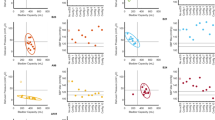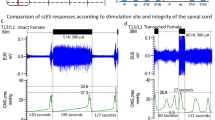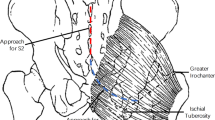Key Points
-
Neurogenic bladder dysfunction, such as detrusor muscle hyperactivity and dyssynergia with the external urethral sphincter (EUS), are common long-term consequences affecting the wellbeing of patients with spinal cord injury (SCI)
-
Various studies have investigated surgical strategies to restore function of a decentralized bladder after SCI via repair of the original roots or by transferring new axonal sources
-
The Finetech-Brindley stimulation device is effective in triggering bladder contraction in patients with neurogenic bladder dysfunction caused by upper motor neuron lesion
-
Surgical techniques for restoring bladder volume, without also inducing a high increase in bladder pressure, are needed to promote efficient storage and continence
-
Development of surgical techniques to reinnervate both the detrusor muscle and the EUS are needed to promote coordinated detrusor–EUS function
-
Comprehensive assessment of the effectiveness of surgical procedures can guide future research and potential clinical application
Abstract
During the past century, diverse studies have focused on the development of surgical strategies to restore function of a decentralized bladder after spinal cord or spinal root injury via repair of the original roots or by transferring new axonal sources. The techniques included end-to-end sacral root repairs, transfer of roots from other spinal segments to sacral roots, transfer of intercostal nerves to sacral roots, transfer of various somatic nerves to the pelvic or pudendal nerve, direct reinnervation of the detrusor muscle, or creation of an artificial reflex pathway between the skin and the bladder via the central nervous system. All of these surgical techniques have demonstrated specific strengths and limitations. The findings made to date already indicate appropriate patient populations for each procedure, but a comprehensive assessment of the effectiveness of each technique to restore urinary function after bladder decentralization is required to guide future research and potential clinical application.
This is a preview of subscription content, access via your institution
Access options
Subscribe to this journal
Receive 12 print issues and online access
$209.00 per year
only $17.42 per issue
Buy this article
- Purchase on Springer Link
- Instant access to full article PDF
Prices may be subject to local taxes which are calculated during checkout



Similar content being viewed by others
References
Anderson, K. D. Targeting recovery: priorities of the spinal cord-injured population. J. Neurotrauma 21, 1371–1383 (2004).
Cowan, R. E., Nash, M. S. & Anderson, K. D. Exercise participation barrier prevalence and association with exercise participation status in individuals with spinal cord injury. Spinal Cord 51, 27–32 (2013).
Migliorini, C. E., New, P. W. & Tonge, B. J. Quality of life in adults with spinal cord injury living in the community. Spinal Cord 49, 365–370 (2011).
Potter, P. J. Disordered control of the urinary bladder after human spinal cord injury: what are the problems? Prog. Brain Res. 152, 51–57 (2006).
Burns, A. S., Rivas, D. A. & Ditunno, J. F. The management of neurogenic bladder and sexual dysfunction after spinal cord injury. Spine 26 (Suppl. 24), S129–S136 (2001).
Agelan, A., Braverman, A. S., Dean, G. E. & Ruggieri, M. R. Sr. Refinement in the management of the denervated canine urinary bladder using an abdominal vesicostomy. ILAR J. 49, E8–E14 (2007).
Samson, G. & Cardenas, D. D. Neurogenic bladder in spinal cord injury. Phys. Med. Rehabil. Clin. N. Am. 18, 255–274 (2007).
Capoor, J. & Stein, A. B. Aging with spinal cord injury. Phys. Med. Rehabil. Clin. N. Am. 16, 129–161 (2005).
Hackler, R. H. A 25-year prospective mortality study in the spinal cord injured patient: comparison with the long-term living paraplegic. J. Urol. 117, 486–488 (1977).
Imai, K., Kadowaki, T. & Aizawa, Y. Standardized indices of mortality among persons with spinal cord injury: accelerated aging process. Ind. Health 42, 213–218 (2004).
Wilson, J. R., Cadotte, D. W. & Fehlings, M. G. Clinical predictors of neurological outcome, functional status, and survival after traumatic spinal cord injury: a systematic review. J. Neurosurg. Spine 17 (Suppl. 1), 11–26 (2012).
Stover, S. L. & Fine, P. R. The epidemiology and economics of spinal cord injury. Paraplegia 25, 225–228 (1987).
Thietje, R., Pouw, M. H., Schulz, A. P., Kienast, B. & Hirschfeld, S. Mortality in patients with traumatic spinal cord injury: descriptive analysis of 62 deceased subjects. J. Spinal Cord Med. 34, 482–487 (2011).
van den Berg, M. E., Castellote, J. M., de Pedro-Cuesta, J. & Mahillo-Fernandez, I. Survival after spinal cord injury: a systematic review. J. Neurotrauma 27, 1517–1528 (2010).
Kilvington, B. Report C. An investigation on the regeneration of nerves, with regard to surgical treatment of certain paralysis. Br. Med. J. 1, 988–990 (1907).
Kilvington, B. An investigation on the regeneration of nerves, with regard to the surgical treatment of certain paralyses. Br. Med. J. 1, 177–179 (1912).
Trumble, H. C. Experimental reinnervation of the paralyzed bladder. Med. J. Aust. 1, 118 (1935).
Barbe, M. F. et al. Feasibility of a femoral nerve motor branch for transfer to the pudendal nerve for restoring continence: a cadaveric study. J. Neurosurg. Spine 15, 526–531 (2011).
Barbe, M. F. & Ruggieri, M. R. Sr. Innervation of parasympathetic postganglionic neurons and bladder detrusor muscle directly after sacral root transection and repair using nerve transfer. Neurourol. Urodyn. 30, 599–605 (2011).
Brown, J. M., Barbe, M. F., Albo, M. E., Lai, H. H. & Ruggieri, M. R. Sr. Anatomical feasibility of performing intercostal and ilioinguinal nerve to pelvic nerve transfer: a possible technique to restore lower urinary tract innervation. J. Neurosurg. Spine 17, 357–362 (2012).
Brown, J. M., Barbe, M. F., Albo, M. E. & Ruggieri, M. R. Sr. Anatomical feasibility of performing a nerve transfer from the femoral branch to bilateral pelvic nerves in a cadaver: a potential method to restore bladder function following proximal spinal cord injury. J. Neurosurg. Spine 18, 598–605 (2013).
Carlsson, C. A. & Sundin, T. Reconstruction of efferent pathways to the urinary bladder in a paraplegic child. Rev. Surg. 24, 73–76 (1967).
Carlsson, C. A. & Sundin, T. Reconstruction of severed ventral roots innervating the urinary bladder. An experimental study in cats. Scand. J. Urol. Nephrol. 2, 199–210 (1968).
Carlsson, C. A. & Sundin, T. Reconstruction of afferent and efferent nervous pathways to the urinary bladder in two paraplegic patients. Spine 5, 37–41 (1980).
Conzen, M. A. & Sollmann, H. Reinnervation of the urinary bladder after microsurgical reconstruction of transsected caudal fibres. An experimental study in pigs. Urol. Res. 10, 141–144 (1982).
Conzen, M. & Sollmann, H. Reinnervation after microsurgical repair of transected cauda equina fibres. An electromyographic study. Neurochirurgia (Stuttg.) 28, 6–7 (1985).
Frazier, C. H. & Mills, C. K. Intradural root anastomosis for the relief of paralysis of the bladder. J. Am. Med. Assoc. 59, 2202–2206 (1912).
Kilvington, B. An investigation on the regeneration of nerves, with a view to the surgical treatment of certain paralyses. Br. Med. J. 1, 935–940 (1905).
Kimmel, D. L. Urinary bladder function in rats following regeneration of direct and crossed nerve anastomoses. Chic. Med. Sch. Q. 26, 1–12 (1966).
Livshits, A. et al. Reinnervation of the neurogenic bladder in the late period of the spinal cord trauma. Spinal Cord 42, 211–217 (2004).
Patil, A. Intercostal nerves to spinal nerve roots anastomosis (spinal cord bypass) and Harrington rod fusion in traumatic paraplegia—technical note. Acta Neurochir. (Wien) 57, 299–303 (1981).
Rao, C. R., Bruce, A. W., Lywood, D. W. & Robertson, D. M. Reinnervation of the neurogenic bladder with somatic motor nerves. Invest. Urol. 9, 59–63 (1971).
Ruggieri, M. R. Sr et al. Reinnervation of urethral and anal sphincters with femoral motor nerve to pudendal nerve transfer. Neurourol. Urodyn. 30, 1695–1704 (2011).
Ruggieri, M. R., Braverman, A. S., D'Andrea, L., Betz, R. & Barbe, M. F. Functional reinnervation of the canine bladder after spinal root transection and genitofemoral nerve transfer at one and three months after denervation. J. Neurotrauma 25, 401–409 (2008).
Ruggieri, M. R., Braverman, A. S., D'Andrea, L., McCarthy, J. & Barbe, M. F. Functional reinnervation of the canine bladder after spinal root transection and immediate somatic nerve transfer. J. Neurotrauma 25, 214–224 (2008).
Ruggieri, M. R. et al. Functional reinnervation of the canine bladder after spinal root transection and immediate end-on-end repair. J. Neurotrauma 23, 1125–1136 (2006).
Sundin, T. & Carlsson, C. A. Reconstruction of severed dorsal roots innervating the urinary bladder. An experimental study in cats. I. Studies on the normal afferent pathways in the pelvic and pudendal nerves. Scand. J. Urol. Nephrol. 6, 176–184 (1972).
Sundin, T. & Carlsson, C. A. Reconstruction of severed dorsal roots innervating the urinary bladder. An experimental study in cats. II. Regeneration studies. Scand. J. Urol. Nephrol. 6, 185–196 (1972).
Vorstman, B., Schlossberg, S. & Kass, L. Investigations on urinary bladder reinnervation. Historical perspective and review. Urology 30, 89–96 (1987).
Vorstman, B., Schlossberg, S., Kass, L., Devine, C. J. Jr & Horton, C. E. Spinal nerve root surgery for urinary bladder reinnervation. Neurourol. Urodyn. 5, 327–333 (1986).
Vorstman, B., Schlossberg, S. M., Kass, L. & Devine, C. J. Jr. Urinary bladder reinnervation. J. Urol. 136, 964–969 (1986).
Vorstman, B., Schlossberg, S., Landy, H. & Kass, L. Nerve crossover techniques for urinary bladder reinnervation: animal and human cadaver studies. J. Urol. 137, 1043–1047 (1987).
Xiao, C. G., de Groat, W. C., Godec, C. J., Dai, C. & Xiao, Q. “Skin–CNS–bladder” reflex pathway for micturition after spinal cord injury and its underlying mechanisms. J. Urol. 162, 936–942 (1999).
Xiao, C. G. & Godec, C. J. A possible new reflex pathway for micturition after spinal cord injury. Paraplegia 32, 300–307 (1994).
Xiao, C. G. et al. An artificial somatic–central nervous system–autonomic reflex pathway for controllable micturition after spinal cord injury: preliminary results in 15 patients. J. Urol. 170, 1237–1241 (2003).
Xiao, C. G. et al. An artificial somatic–autonomic reflex pathway procedure for bladder control in children with spina bifida. J. Urol. 173, 2112–2116 (2005).
Xiao, C. G. Reinnervation for neurogenic bladder: historic review and introduction of a somatic–autonomic reflex pathway procedure for patients with spinal cord injury or spina bifida. Eur. Urol. 49, 22–28; discussion 28–29 (2006).
De Groat, W. C. Nervous control of the urinary bladder of the cat. Brain Res. 87, 201–211 (1975).
De Groat, W. C. & Lalley, P. M. Reflex firing in the lumbar sympathetic outflow to activation of vesical afferent fibres. J. Physiol. 226, 289–309 (1972).
Thulin, C. A. & Carlsson, C. A. Regeneration of transected ventral roots submitted to monomolecular filter tubulation (millipore). An experimental study in cats. J. Neurol. Sci. 8, 485–505 (1969).
Campbell, J. B. & Bassett, C. A. The surgical application of monomolecular filters (Millipore) to bridge gaps in peripheral nerves and to prevent neuroma formation. Surg. Forum. 7, 570–574 (1957).
Bassett, C. A., Campbell, J. B. & Husby, J. Peripheral nerve and spinal cord regeneration: factors leading to success of a tubulation technique employing millipore. Exp. Neurol. 1, 386–406 (1959).
Meier, C. & Sollmann, H. Regeneration of cauda equina fibres after transsection and end-to-end suture. Light and electron microscopic study in the pig. J. Neurol. 215, 81–90 (1977).
Meier, C. & Sollmann, H. Glial outgrowth and central-type myelination of regenerating axons in spinal nerve roots following transection and suture: light and electron microscopic study in the pig. Neuropathol. Appl. Neurobiol. 4, 21–35 (1978).
Baron, R. & Jänig, W. Neurons projecting rostrally in the hypogastric nerve of the cat. J. Auton. Nerv. Syst. 24, 81–86 (1988).
Baron, R., Jänig, W. & McLachlan, E. M. The afferent and sympathetic components of the lumbar spinal outflow to the colon and pelvic organs in the cat. I. The hypogastric nerve. J. Comp. Neurol. 238, 135–146 (1985).
Jänig, W., Schmidt, M., Schnitzler, A. & Wesselmann, U. Differentiation of sympathetic neurones projecting in the hypogastric nerves in terms of their discharge patterns in cats. J. Physiol. 437, 157–179 (1991).
Elliott, T. R. The innervation of the bladder and urethra. J. Physiol. 35, 367–445 (1907).
Edge, N. D. A contribution to the innervation of the urinary bladder of the cat. J. Physiol. 127, 54–68 (1955).
Ingersoll, E. H., Jones, L. L. & Hegre, E. S. Urinary bladder response to unilateral stimulation of hypogastric nerves. J. Urol. 72, 178–190 (1954).
Ingersoll, E. H. & Jones, L. L. Effect upon the urinary bladder of unilateral stimulation of hypogastric nerves in the dog. Anat. Rec. 130, 605–615 (1958).
Ingersoll, E. H., Jones, L. L. & Hegre, E. S. Effect on urinary bladder of unilateral stimulation of pelvic nerves in the dog. Am. J. Physiol. 189, 167–172 (1957).
Weiss, P. Nerve regeneration in the rat following tubular splicing of severed nerves. Arch. Surg. 46, 525–547 (1943).
Zhang, S., Wang, Y. & Johnston, L. Restoration of function in complete spinal cord injury using peripheral nerve rerouting: a summary of procedures. Surg. Technol. Int. 17, 287–291 (2008).
Xiao, C. G. & Godec, C. J. A possible new reflex pathway for micturition after spinal cord injury. Paraplegia 32, 300–307 (1994).
Lin, H., Hou, C., Zhen, X. & Xu, Z. Clinical study of reconstructed bladder innervation below the level of spinal cord injury to produce urination by Achilles tendon-to-bladder reflex contractions. J. Neurosurg. Spine 10, 452–457 (2009).
Tuite, G. F. et al. Attempted bladder reinnervation and creation of a scratch reflex for bladder emptying through a somatic-to-autonomic intradural anastomosis. J. Neurosurg. Pediatr. 12, 80–86 (2013).
Peters, K. M. et al. Outcomes of lumbar to sacral nerve rerouting for spina bifida. J. Urol. 184, 702–707 (2010).
Peckham, P. H. & Knutson, J. S. Functional electrical stimulation for neuromuscular applications. Annu. Rev. Biomed. Eng. 7, 327–360 (2005).
Ragnarsson, K. T. Functional electrical stimulation after spinal cord injury: current use, therapeutic effects and future directions. Spinal Cord 46, 255–274 (2008).
Sooksood, K., Stieglitz, T. & Ortmanns, M. An active approach for charge balancing in functional electrical stimulation. IEEE Trans. Biomed. Circuits Syst. 4, 162–170 (2010).
Talalla, A., Bloom, J. W. & Quang, N. FES for bladder: direct or indirect means? Pacing Clin. Electrophysiol. 10, 240–245 (1987).
Heine, J. P., Schmidt, R. A. & Tanagho, E. A. Intraspinal sacral root stimulation for controlled micturition. Invest. Urol. 15, 78–82 (1977).
Brindley, G. S. An implant to empty the bladder or close the urethra. J. Neurol. Neurosurg. Psychiatry 40, 358–369 (1977).
Schmidt, R. A., Bruschini, H. & Tanagho, E. A. Feasibility of inducing micturition through chronic stimulation of sacral roots. Urology 12, 471–477 (1978).
Schmidt, R. A., Bruschini, H. & Tanagho, E. A. Urinary bladder and sphincter responses to stimulation of dorsal and ventral sacral roots. Invest. Urol. 16, 300–304 (1979).
Schmidt, R. A., Bruschini, H. & Tanagho, E. A. Sacral root stimulation in controlled micturition. Peripheral somatic neurotomy and stimulated voiding. Invest. Urol. 17, 130–134 (1979).
De Groat, W. C., Booth, A. M. & Yoshimura, N. in Nervous Control of the Urogenital System (ed. Maggi, C. A.) 227–290 (Harwood Academic Publishers, 1993). [Series ed. Burnstock, G. The Autonomic Nervous System Vol. 3].
de Groat, W. C. et al. Neural control of the urethra. Scand. J. Urol. Nephrol. Suppl. 2001, 35–43; discussion 106–125 (2001).
Shefchyk, S. J. Spinal cord neural organization controlling the urinary bladder and striated sphincter. Prog. Brain Res. 137, 71–82 (2002).
Macarak, E. J. et al. The collagens and their urologic implications. Adv. Exp. Med. Biol. 385, 173–177; discussion 179–184 (1995).
Macarak, E. J. & Howard, P. S. in Advances in Bladder Research (eds Baskin, L. S. & Hayward, S. W.) 215–223 (Springer, 1999). [Series eds Back, N., Cohen, I. R., Kritchevsky, D., Lajtha, A. & Paoletti, R. Advances in Experimental Medicine and Biology Vol. 462].
Acknowledgements
The projects described were supported by Award Number R01NS070267 and NS070267-S1 to M.F.B. and M.R.R. from the National Institute of Neurological Disorders and Stroke. The content of this Review is solely the responsibility of the authors and does not necessarily represent the official views of the National Institute of Neurological Disorders and Stroke or the National Institutes of Health.
Author information
Authors and Affiliations
Contributions
S.M.G.-A. and M.F.B. are joint first authors on this manuscript. S.M.G.-A., M.F.B. and M.R.R. researched data for and wrote the article. All authors contributed to discussion of the content. M.F.B., W.C.d.G., J.M.B. and M.R.R. reviewed/edited the manuscript before submission.
Corresponding author
Ethics declarations
Competing interests
The authors declare no competing financial interests.
PowerPoint slides
Rights and permissions
About this article
Cite this article
Gomez-Amaya, S., Barbe, M., de Groat, W. et al. Neural reconstruction methods of restoring bladder function. Nat Rev Urol 12, 100–118 (2015). https://doi.org/10.1038/nrurol.2015.4
Published:
Issue Date:
DOI: https://doi.org/10.1038/nrurol.2015.4
This article is cited by
-
Innervation: the missing link for biofabricated tissues and organs
npj Regenerative Medicine (2020)
-
Assessment of feasibility of neuronal reinnervation of pudendal nerve by femoral nerve’s motor branch to vastus lateralis: an ultrasound-guided study
European Journal of Plastic Surgery (2020)
-
Bladder Re-Innervation—State of the Art
Current Bladder Dysfunction Reports (2016)








